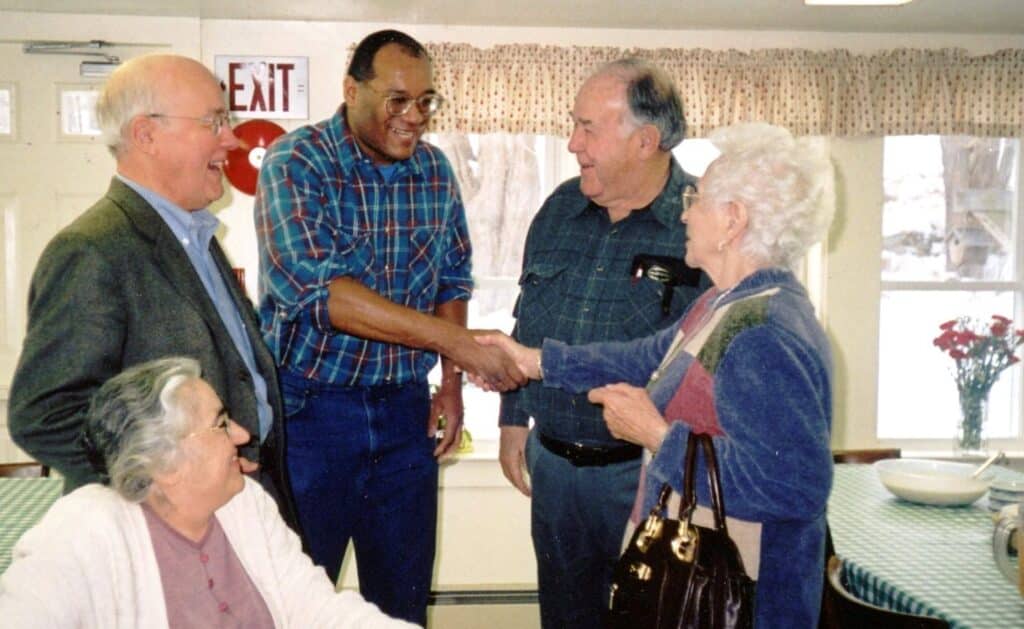A Beautiful Scene
Last fall I went with my dad to the annual Camp Deerpark homecoming. It was his third trip to camp in a month—he had already attended a pastors’ retreat and a two-day meeting of the New York City Council of Mennonite Churches (NYCCMC) Executive Committee. We were approaching the chapel when he commented that the experience of driving up Brandt Road had changed since the early days. How so? “It’s paved! The ride is so much less bumpy and dusty than it was in the beginning!”
Very soon we were experiencing two aspects of arriving at camp that have remained constant over the years: the lovely view of the expansive lawn, suddenly visible, and the welcoming smiles and waves from people already happily enjoying the grounds. My dad described being impressed by his first glimpse of camp in December 1968, prior to the actual purchase by the Mennonite churches: “There was fresh snow covering the ground, bright sunshine reflecting off the snow, and, near the casino—now the chapel—there was a deer calmly eating fruit fallen from a bare apple tree. A beautiful scene!”
Although I don’t have any memory of being there that day, my dad says I was—that my mom and brother were there, too, and that we rode along with Glenn and Florence Zeager. “The council had pretty well decided to buy the property, and Glenn wanted as many council members as possible to see it before the final decision was made,” he said. “So he got permission from the real estate agent to bring us up after church one Sunday. The agent wasn’t there, but he’d told the property caretaker to let us look around. We didn’t have access to all the buildings, but we were able to go inside the main building and several others, and to get a feel for the place. It seemed like a good fit. But we knew it was a big decision.”
Perhaps I don’t remember that first trip because I was only six years old. Unlike the adults, I had no concept of the scale of the financial commitment, or the intricacies of establishing an appropriate administrative structure, or the potential for Camp Deerpark to play a central role in shaping the emerging identity of the New York City Mennonite churches. “One of the best decisions the council made was to commit to buying and operating camp together,” my dad said. “This was not going to be a situation where we operated as Lancaster Conference churches and Ohio and Eastern Conference (now Atlantic Coast Conference) churches—we were committed to this project as New York City Mennonite churches.”
As I told my dad about my first camp memory, I realized it was an experience that exemplified camp belonging to us: “It was springtime, and there were lots of people from lots of churches, and we played while the adults worked, and everyone had lunch together in the dining room.” What was going on? “Must have been a ‘Camp Cleanup Day,’” he said. “In fact, it may have been the first one. We wanted as many people as possible to have an introduction to camp. And there was work that needed to be done before the children’s summer program started, so we got together to celebrate and get ready.”
“I liked being around church when the bus came to pick up the campers, and when they came back again the following week,” he told me. “Generally it was relatively quiet when they left. But when they came home, the energy and the noise level was bumped up several notches! I really enjoyed experiencing their enthusiasm and seeing that the children had really gotten to know each other.” Church retreats served a similar purpose, he added. “For years, Seventh Avenue had a summer retreat and a winter retreat. Community people were welcome, and camp was a wonderful setting for becoming better acquainted.”
He asked if I remembered the small golf course that used to be below the main house, and told me a story I had never heard before: “One afternoon, after we played a round of golf, several of us sat down in the shade to relax. It was a really beautiful summer day, with just enough breeze to be really pleasant. This was in the early 1970s.”
“At the time, the janitor for our Head Start program lived upstairs from the church, and although he didn’t attend our church services, he came to retreats. He often brought along his daughter and her family, who lived in Brooklyn. His son-in-law was one of the golfers that day. After we’d been sitting and chatting for a little while, the young man announced, ‘It’s so peaceful here. I don’t think I’ll be needing this anymore.’ Then he lifted up his pant leg, unstrapped his ankle holster, and offered the gun to Dick [Pannell, the pastor at the time], and then to me. We both declined, saying we didn’t need it either. So he shrugged and put it in his pocket. And that was that.
”I recently found a small package of black and white photos. On the envelope my mother had written: Church Camp Retreat, June 1970. There are pictures of people—black and white, all ages—talking and laughing, sitting on the porch and emerging from the chapel. There are pictures of people—children and grownups—jumping Double Dutch and golfing.
It’s been almost 50 years since those photos were taken, and some of the people in those pictures have died. Some of the kids in those pictures have sent their own children to Camp Deerpark. In fact, at the 2017 homecoming, I even saw the grandchildren of one of those children. That morning we rode up to camp in my dad’s red 2015 Hybrid Ford C-Max—which, he assures me is a far cry from Glenn Zeager’s spiffy black 1948 Packard, which took us up bumpy, dusty Brandt Road on our first visit to camp. But this hasn’t changed: Camp Deerpark belongs to us. And we belong to each other.
—Written by Naomi Yoder, former camper and member of Infinity Mennonite Church in Harlem.
Monroe J. Yoder, retired bishop of the New York City District of Lancaster Mennonite Conference, has attended Seventh Avenue Mennonite Church in Harlem since 1965 (the name of the congregation was changed to Infinity Mennonite Church in 2009).
Related Entries
Share:
“How Do I Donate?”
Recently, a thirteen-year-old guest at Camp asked Operations Director Kevin Smith, “how do I donate?” Kevin was honestly a little surprised, but was happy to see this young member – who was on retreat with one of our owning churches — taking some initiative. Kevin directed him to the website Donate page, and the young…
The Discipleship Down-Low
Defining Discipleship 18 And Jesus came and said to them, “All authority in heaven and on earth has been given to me. 19 Go therefore and make disciples of all nations, baptizing them in the name of the Father and of the Son and of the Holy Spirit, 20 teaching them to observe all that I have commanded…
The Virtuous Wife
This past weekend, Camp hosted three women’s retreats at Camp. Though the retreat groups were very diverse in background – one was from an urban church plant in Philadelphia, one was from a Garifuna Mennonite church in Brooklyn (an Afro-Caribbean Culture), and one was from a multi-ethnic faith community reaching out in North Jersey. Though…
A Life of Service
I believe the most important thing to God is not our personality, knowledge, or talents, but our availability. How willing and ready are we to respond when He calls, and how ready are we to do what He says? What use to the Lord are people who could do what he wants with excellence and…
Building Belonging
At our February NYC LMC District meeting, we’re discussing the Belonging phase of The Journey Map. In this first phase on the map, individuals and groups on a spiritual journey begin the process of connecting to each other and evaluating the place they may have in each other’s lives. Have you ever been an outsider…
What Are You Tapped Into?
Yesterday we began tapping maple trees, officially opening maple syrup making season at Camp Deerpark! Last year, the transition kept us from producing syrup, so it feels great to be back to it. Starting off, however, has been a bit of a challenge since things are pretty arctic around here. The entire ground is covered…
What Does it Mean to be Spirit-Led with Pastor Mark Perri
One small contribution I can make is to share story with you. This could be valuable in several ways: First, I’m coming to the Mennonites from the outside — from non-denominational GenX “simple/ organic/ emergent church“. Sometimes people coming from outside-in have a helpful perspective for those trying to move from inside-out. Second, as an…
2025 NYC LMC District Call Schedule
Mark these dates in your calendar if you’re part of the NYC LMC District and want to attend the English-language fellowship and resourcing calls led by Bishop Hyacinth Stevens: January 27th – 6:30 PM February 24th – 6:30 PM March 31st – 6:30 PM April 28th – 6:30 PM May 19th – 6:30 PM June 30th…
Winter: Life Under the Surface
On the surface, winter with its cracking and cold seems like the enemy of life. Everything sleeps as though dead, and Camp — quiet and empty — sits waiting. But under the surface, winter is revealed to be a friend to life, not an enemy. In the deep frost, God opens the soil for Spring’s…
Peace Making Presents
This is Session 4 of the Prince of Peace: Jesus and Peacebuilding from the Election to the Holidays webinar series. Advent celebrates the central fact that God began building peace with us by giving a Gift. Following this example, gifts are a powerful tool for peacebuilding in our lives, relationships, and organizations. We’ll explore how…




